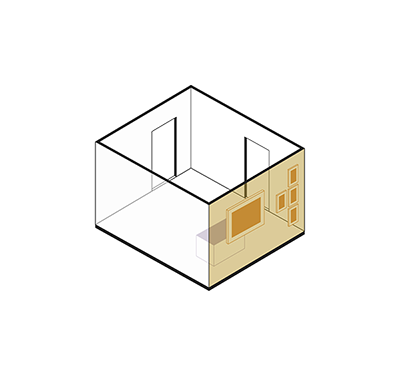Mandala of the five transcendental Buddhas
See it in the Museum

Reception desk
Orientation 2
Wall object 9

ABP 046
Code: ABP 046
Country: Nepal (Dolpo)
Style:
Date: 1400 - 1500
Dimensions in cm WxHxD: 140 x 114
Materials: Painted wood
Mandala of the five transcendental Buddhas
This mandala painted on wood possibly formed the ceiling of a stupa. It represents the five transcendental Buddhas who rule over the five spiritual families, each corresponding to a specific mental poison transmuted into wisdom, a specific colour and a cardinal direction.
• In the centre sits white Vairochana, “the Illuminator,” Lord of the Buddha family. Performing the teaching gesture, he represents victory over ignorance and stupidity.
• Facing him in the east is blue Akshobhya, the “Unshakable One,” Lord of the Vajra family. Touching the ground before him, he vanquishes hatred and aversion.
• In the south is yellow Ratnasambhava, the “Jewel born,” Lord of the Jewel family. With his hand in the generosity gesture, he transcends pride.
• In the west is red Amitabha, “Infinite Light,” Lord of the Lotus family. With both hands in contemplation, he stands for victory over desire and attachment.
• Finally, to the north is green Amoghasiddhi, “Accomplisher of what is meaningful,” Lord of the Karma family. Performing the protection gesture, he triumphs over jealousy and envy.
On the outer rim are placed human and divine figures also enclosed into circles. Among them is the Indian tantric master Padmasambhava.
This mandala painted on wood possibly formed the ceiling of a stupa. It represents the five transcendental Buddhas who rule over the five spiritual families, each corresponding to a specific mental poison transmuted into wisdom, a specific colour and a cardinal direction.
• In the centre sits white Vairochana, “the Illuminator,” Lord of the Buddha family. Performing the teaching gesture, he represents victory over ignorance and stupidity.
• Facing him in the east is blue Akshobhya, the “Unshakable One,” Lord of the Vajra family. Touching the ground before him, he vanquishes hatred and aversion.
• In the south is yellow Ratnasambhava, the “Jewel born,” Lord of the Jewel family. With his hand in the generosity gesture, he transcends pride.
• In the west is red Amitabha, “Infinite Light,” Lord of the Lotus family. With both hands in contemplation, he stands for victory over desire and attachment.
• Finally, to the north is green Amoghasiddhi, “Accomplisher of what is meaningful,” Lord of the Karma family. Performing the protection gesture, he triumphs over jealousy and envy.
On the outer rim are placed human and divine figures also enclosed into circles. Among them is the Indian tantric master Padmasambhava.

